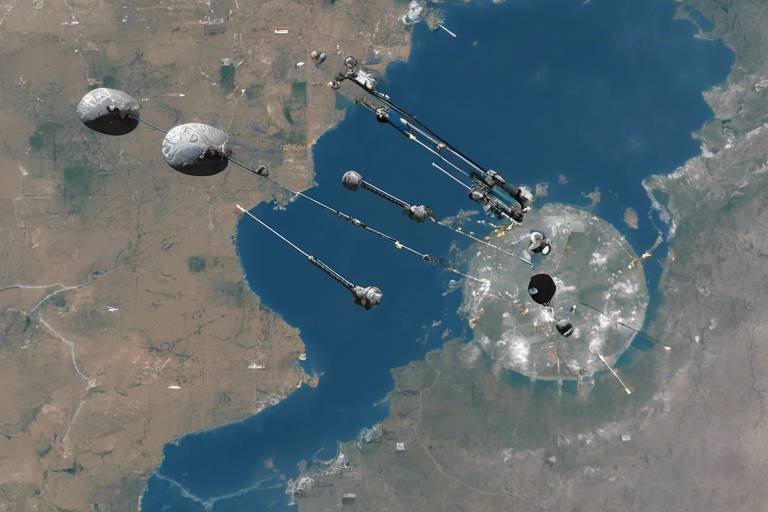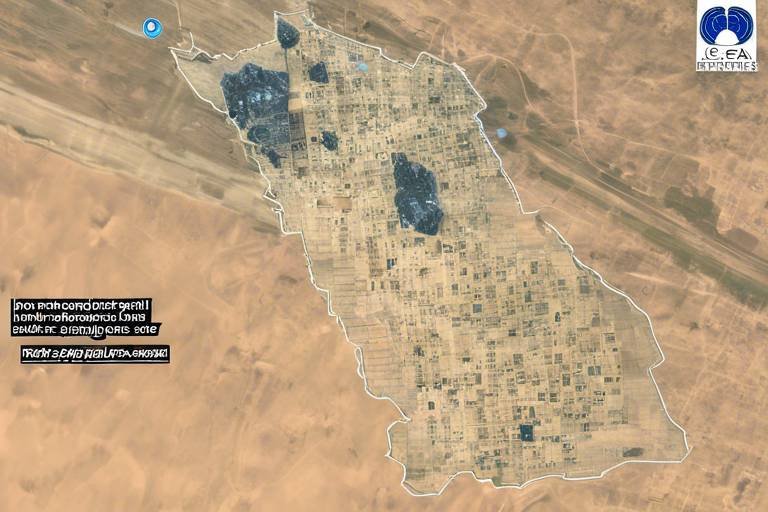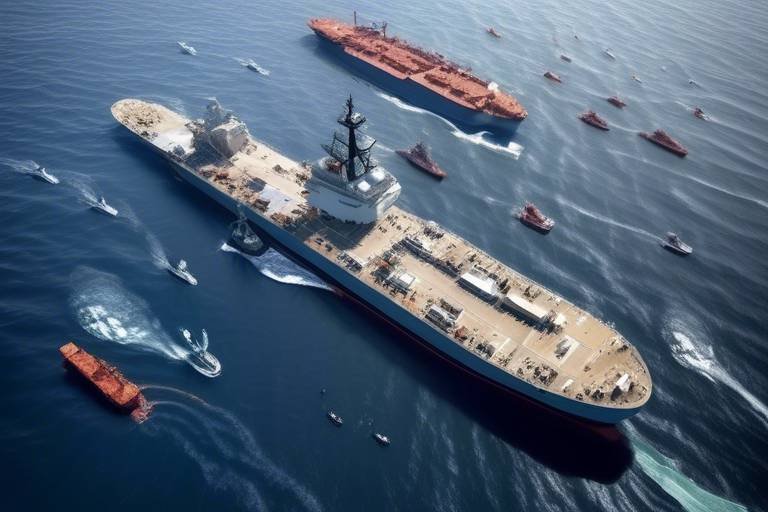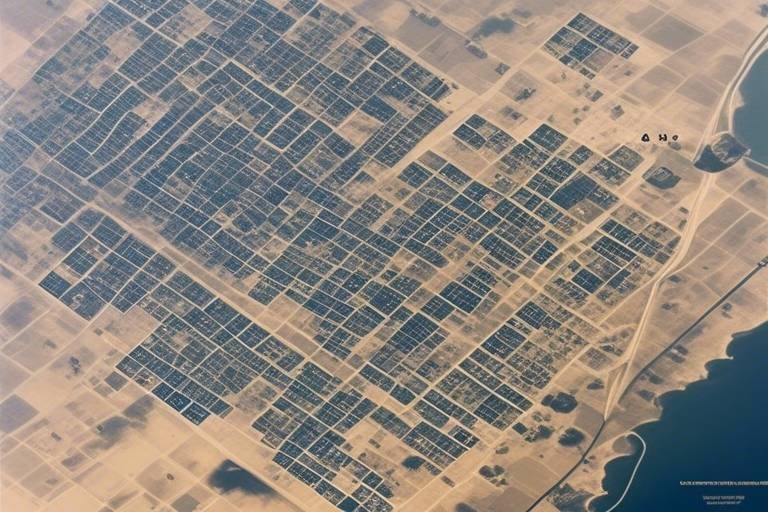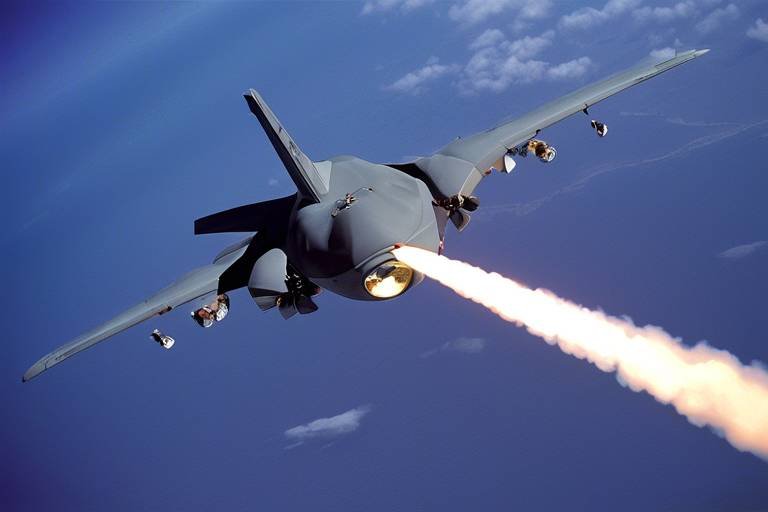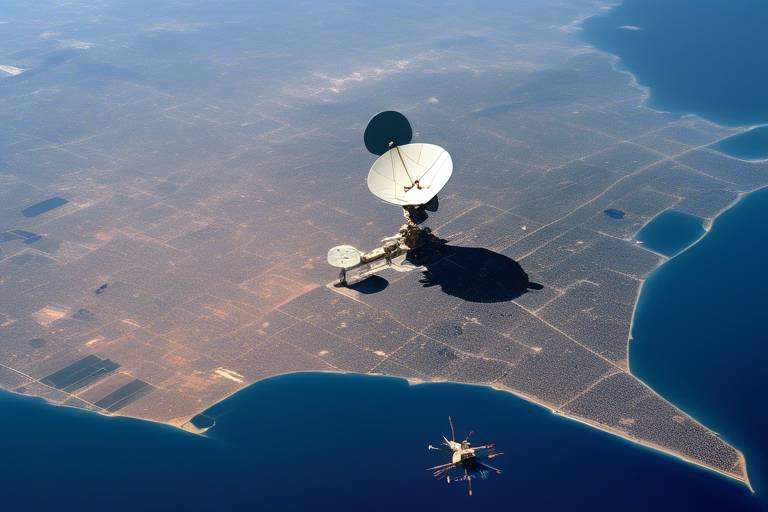How Satellite Technology Supports Cyber Warfare
In the age of modern warfare, the battlefield has expanded beyond traditional ground and air combat. Today, cyber warfare has emerged as a pivotal element of military strategy, where information and technology play a crucial role. At the heart of this evolution lies satellite technology, serving as a backbone for military operations, surveillance, and secure communication. But how exactly do these floating marvels support cyber warfare?
First and foremost, satellites are integral to gathering and analyzing intelligence. They provide real-time data that enhances situational awareness for military operations and cyber defense strategies. Imagine being able to monitor enemy movements from thousands of miles away; this capability transforms the way military planners strategize and execute their missions. The ability to observe and collect data from space offers a significant advantage, allowing for informed decision-making in high-stakes environments.
Moreover, the role of satellite communication networks cannot be overstated. These networks are vital for ensuring secure and reliable communication among military units. When a cyber threat arises, the need for rapid response is critical. With satellites facilitating instantaneous communication, military forces can coordinate their cyber operations effectively, sharing intelligence and executing plans without delay. This level of connectivity is akin to having a digital command center in the sky, where every unit is linked and ready to respond at a moment's notice.
However, this reliance on satellite technology also brings forth challenges. The implementation of advanced encryption techniques in satellite communications is necessary to safeguard sensitive data from potential cyber attacks. Just as a fortress protects its treasures, encryption acts as a shield, ensuring that military communications remain confidential. Yet, despite these measures, satellites face significant security vulnerabilities, including hacking and jamming. These threats can disrupt not only communication but also the entire cyber warfare strategy, making it imperative for military organizations to develop robust mitigation strategies.
To counter these threats, military organizations are investing in redundancy systems and enhanced cybersecurity protocols for satellite operations. This proactive approach is essential in an era where cyber warfare tactics are continuously evolving. Imagine a game of chess, where each move must be calculated and anticipated; military strategists are doing just that, ensuring their satellite operations are resilient against potential disruptions.
In addition to intelligence and communication, satellites play a critical role in data collection and surveillance. They enable military forces to monitor enemy movements and cyber activities from space, providing a comprehensive view of the battlefield. This capability allows for the identification of potential cyber threats and vulnerabilities within enemy infrastructure, facilitating preemptive actions. The integration of satellite technology into military strategy has transformed how nations approach cyber warfare, influencing tactical decisions and operational planning.
As we look to the future, the trends in satellite-supported cyber warfare are poised to evolve further. Advancements in artificial intelligence and automation will likely enhance operational capabilities and effectiveness. Innovative technologies, such as small satellites and nanosatellites, are being developed to improve surveillance and communication capabilities in cyber warfare scenarios. These emerging technologies will not only increase the efficiency of military operations but also raise questions about international regulations and the need for agreements to prevent space-based conflicts.
In conclusion, satellite technology is a game changer in the realm of cyber warfare. It enhances military operations through improved intelligence gathering, secure communication, and real-time decision-making. As technology evolves, the symbiotic relationship between satellites and cyber warfare will only grow stronger, shaping the future of military strategy in ways we are only beginning to understand.
- How do satellites enhance military communication? Satellites provide secure and reliable communication channels that allow military units to coordinate their operations effectively and respond quickly to threats.
- What are the main challenges facing satellite security? Satellites are vulnerable to hacking, jamming, and other cyber threats, which can compromise military operations and strategies.
- What role does encryption play in satellite communications? Encryption protects sensitive military data transmitted via satellite, ensuring that communications remain confidential and secure from adversaries.
- How is artificial intelligence changing satellite technology in warfare? AI is being integrated into satellite operations to enhance data analysis, improve decision-making processes, and automate certain tasks, making military operations more efficient.
Role of Satellites in Cyber Intelligence
In the realm of modern warfare, satellites have become indispensable tools for gathering and analyzing intelligence. Imagine a vast network of eyes in the sky, constantly watching over the battlefield, collecting data, and providing crucial insights that can turn the tide of conflict. These orbiting sentinels are capable of delivering real-time information that enhances situational awareness for military operations and cyber defense strategies. By integrating satellite technology into their operations, military forces can stay several steps ahead of their adversaries, making informed decisions based on comprehensive intelligence.
Satellites contribute to cyber intelligence in several key ways:
- Surveillance and Reconnaissance: Satellites equipped with advanced imaging technology can monitor enemy movements and infrastructure, providing a bird's-eye view of potential threats. This capability is crucial for assessing the battlefield dynamics and understanding the enemy's cyber posture.
- Data Analysis: The data collected from satellites undergoes rigorous analysis using sophisticated algorithms and artificial intelligence. This process helps in identifying patterns and anomalies that could indicate cyber threats or vulnerabilities.
- Signal Intelligence: Satellites can intercept and analyze communications between enemy units, offering insights into their strategies and intentions. This intelligence is vital for preemptive actions and countermeasures.
The role of satellites in cyber intelligence is not just about gathering data; it's about transforming that data into actionable intelligence. For instance, when a satellite detects unusual cyber activity in a specific region, military analysts can quickly assess the situation, determine the potential risks, and deploy resources accordingly. This level of agility is what separates effective military operations from those that falter in the face of uncertainty.
Moreover, the integration of satellite technology into cyber intelligence enhances collaboration among allied forces. By sharing satellite-derived intelligence, nations can strengthen their collective defense strategies, ensuring that they are better prepared to confront emerging threats. This collaborative approach is essential in an age where cyber warfare knows no borders, and the ability to share critical information can be the difference between victory and defeat.
In conclusion, the role of satellites in cyber intelligence is a game-changer in modern warfare. They not only provide vital data but also facilitate swift decision-making and strategic planning. As technology continues to evolve, the capabilities of satellites will only expand, further solidifying their position as essential assets in the fight against cyber threats.
Communication Networks and Cyber Warfare
In the realm of modern warfare, communication networks are the backbone that supports military operations, especially in the context of cyber warfare. Imagine trying to orchestrate a complex dance without music; that’s what military units would be doing without reliable communication. Satellite communication networks provide the necessary infrastructure for secure and efficient communication among military units, enabling them to coordinate their cyber operations effectively. This capability is not just a luxury; it's a necessity in today's fast-paced conflict environments.
When it comes to cyber warfare, the stakes are incredibly high. The ability to share information rapidly and securely can mean the difference between victory and defeat. Satellite networks allow for real-time communication, which is essential for responding to threats as they arise. For instance, if a cyber attack is detected, military personnel can instantly communicate with each other, sharing vital information that helps them understand the nature of the threat and devise an appropriate response. This swift action is crucial in neutralizing potential risks before they escalate.
Moreover, the integration of satellite technology into communication networks enhances the resilience of military operations. Traditional communication methods can be vulnerable to interception and disruption, but satellite communications, when properly secured, offer a more robust alternative. By employing advanced encryption techniques, military communications can remain secure even in the face of sophisticated cyber attacks. This is akin to having a fortified castle with high walls; it makes it significantly harder for adversaries to breach your defenses.
The implementation of encryption in satellite communications is a game-changer. It ensures that sensitive data transmitted between units is protected from prying eyes. Think of encryption as a secret code that only the intended recipients can understand. This layer of security is vital in cyber warfare, where information can be as powerful as any weapon. The military's ability to safeguard its communications allows for more strategic planning and execution of operations without the fear of being compromised.
However, the journey is not without its challenges. Satellites themselves face significant security vulnerabilities. Hackers and cybercriminals are constantly developing new methods to exploit weaknesses in satellite systems. Jamming and spoofing attacks can disrupt communications, leading to confusion and chaos during critical operations. The reality is that while satellites have revolutionized communication in warfare, they remain a target for those looking to gain an advantage.
To counteract these threats, military organizations are developing robust mitigation strategies. This includes creating redundancy systems, which act like backup plans in case the primary communication channels fail. Enhanced cybersecurity protocols are also being implemented to protect satellite operations from potential breaches. It's akin to having multiple escape routes in a building; if one path is blocked, there are alternatives to ensure safety and continuity.
In conclusion, the role of communication networks in cyber warfare cannot be overstated. They are essential for maintaining the flow of information, facilitating rapid decision-making, and ensuring that military operations can be conducted effectively and securely. As technology continues to evolve, the integration of satellite systems will only become more critical in the ongoing battle for cybersecurity and military supremacy.
Encryption and Security Measures
In the realm of cyber warfare, where the stakes are incredibly high, encryption plays a pivotal role in safeguarding sensitive information transmitted via satellite communications. Imagine sending a top-secret military message across the vastness of space, only to have it intercepted by adversaries. This is where encryption comes into play, acting as a digital lock that secures data from prying eyes. By employing advanced encryption techniques, military organizations ensure that even if data packets are intercepted, they remain unreadable and useless to unauthorized entities.
Modern encryption methods utilize complex algorithms that transform readable data into a coded format, which can only be deciphered by those who possess the correct key. This process is akin to sending a letter in a foreign language that only the intended recipient understands. Moreover, encryption is not a one-size-fits-all solution; different types of encryption are used depending on the sensitivity of the information being transmitted. For instance, symmetric encryption uses the same key for both encryption and decryption, while asymmetric encryption employs a pair of keys—one public and one private—to enhance security.
However, it's not just about encrypting the data itself. The entire communication channel must be fortified against potential cyber threats. This involves implementing various security measures, such as:
- Secure Communication Protocols: Utilizing protocols like TLS (Transport Layer Security) ensures that data transmitted over satellite links is encrypted and secure.
- Regular Security Audits: Conducting frequent assessments of satellite systems helps identify vulnerabilities that could be exploited by hackers.
- Multi-Factor Authentication: Requiring multiple forms of verification before granting access to satellite systems adds an extra layer of security.
Despite these robust measures, the threat landscape is constantly evolving. Cyber adversaries are becoming increasingly sophisticated, employing tactics like man-in-the-middle attacks and advanced persistent threats (APTs) to compromise satellite communications. Therefore, military organizations must remain vigilant and proactive in updating their encryption protocols and security measures. This ongoing battle between cyber defenders and attackers is reminiscent of a high-stakes game of chess, where each side must anticipate the other's moves and adapt accordingly.
In conclusion, encryption and security measures are not just technical necessities; they are the backbone of modern military operations that rely on satellite technology. As we advance into an era where cyber warfare is becoming more prevalent, the importance of these measures will only intensify, making it imperative for military forces to stay ahead of the curve.
- What is encryption in satellite communications? Encryption is the process of converting data into a coded format to prevent unauthorized access during transmission.
- Why is encryption important for military operations? It protects sensitive information from interception and ensures secure communication between military units.
- What are the types of encryption used in satellite communications? Common types include symmetric and asymmetric encryption, each serving different security needs.
- How do military organizations ensure the security of satellite communications? They implement secure communication protocols, conduct regular audits, and use multi-factor authentication.
Challenges in Satellite Security
As we delve into the realm of satellite security, it's crucial to recognize that these technological marvels are not impervious to threats. In fact, they face a myriad of challenges that can jeopardize their functionality and, by extension, military operations. One of the most pressing issues is the vulnerability of satellites to hacking. Cybercriminals and hostile nations are constantly developing sophisticated methods to breach satellite systems, aiming to manipulate data or gain unauthorized access to sensitive information. This is akin to a thief trying to pick a lock; if they succeed, the consequences can be catastrophic.
Another significant challenge is jamming. Jamming involves the deliberate transmission of signals to disrupt communication between satellites and ground stations. Imagine trying to have a conversation in a crowded room where someone is blasting music; you simply can't hear each other. In a military context, this disruption can lead to confusion and miscommunication, potentially resulting in disastrous outcomes during critical operations.
Moreover, the increasing number of satellites in orbit raises concerns about space debris. Collisions with debris can damage or destroy satellites, impacting their operational capabilities. This situation is reminiscent of a game of dodgeball, where one must not only aim accurately but also avoid being hit by stray balls. As more entities launch satellites, the risk of collision escalates, presenting a looming threat to satellite security.
Furthermore, the reliance on outdated technology in some satellite systems can make them susceptible to attacks. Just as an old lock can be picked more easily than a modern one, outdated satellites may lack the advanced security features necessary to fend off contemporary threats. This highlights the need for continuous upgrades and investments in satellite technology to ensure robust defense mechanisms.
In summary, the challenges in satellite security are multifaceted, encompassing hacking, jamming, space debris, and outdated technology. Addressing these issues is not just a matter of technological advancement but also requires a strategic approach to ensure that satellite operations remain secure and effective in the face of evolving threats.
- What are the main threats to satellite security?
The main threats include hacking, jamming, and space debris, all of which can compromise the functionality and security of satellite operations.
- How does jamming affect military operations?
Jamming disrupts communication between satellites and ground stations, leading to confusion and miscommunication during critical military operations.
- What can be done to enhance satellite security?
Enhancing satellite security involves upgrading technology, implementing advanced encryption methods, and developing robust protocols to counteract potential threats.
- Why is space debris a concern for satellites?
Space debris poses a collision risk that can damage or destroy satellites, impacting their operational capabilities and overall security.
Mitigation Strategies
In the ever-evolving battlefield of cyber warfare, are essential for safeguarding satellite operations against potential threats. Military organizations around the world are increasingly aware of the vulnerabilities that satellites face, such as hacking, jamming, and other forms of electronic warfare. To combat these risks, they are implementing a multi-layered approach that focuses on both redundancy and enhanced cybersecurity protocols.
One of the primary strategies involves the development of redundant systems. This means that military satellites are designed with backup systems that can take over in case the primary system is compromised or fails. For instance, if a satellite's communication link is jammed, an alternative link can be activated to ensure continuous operation. This redundancy not only enhances the resilience of satellite systems but also provides a safety net during critical missions.
Additionally, cybersecurity protocols are being fortified. Advanced encryption techniques are employed to secure data transmitted between satellites and ground stations. This ensures that even if a malicious actor manages to intercept the data, it remains unreadable without the appropriate decryption keys. Furthermore, military organizations are investing in real-time monitoring tools that can detect anomalies in satellite communications, allowing for immediate responses to potential threats.
Moreover, collaboration with private tech companies has become a pivotal part of these strategies. By leveraging the expertise of cybersecurity firms, military entities can stay ahead of emerging threats. This partnership allows for the rapid deployment of cutting-edge technologies, such as artificial intelligence and machine learning, to analyze vast amounts of data and identify vulnerabilities before they can be exploited.
To sum up, the mitigation strategies being employed in satellite operations are not just about reacting to threats but also about proactively preventing them. As the landscape of cyber warfare continues to change, these strategies will evolve, incorporating new technologies and methodologies to ensure that military satellites remain a secure and reliable component of national defense.
- What are the main threats to satellite operations?
The primary threats include hacking, jamming, and spoofing, which can disrupt communication and data transmission.
- How do redundancy systems work?
Redundancy systems provide backup options that can take over if the primary system fails or is compromised, ensuring continuous operation.
- What role does encryption play in satellite security?
Encryption secures data transmissions, making it unreadable to unauthorized parties, thus protecting sensitive information from cyber attacks.
- How is artificial intelligence used in cybersecurity for satellites?
AI can analyze data patterns and detect anomalies in satellite communications, enabling quicker responses to potential threats.
Data Collection and Surveillance
In the realm of modern warfare, the significance of cannot be overstated. Satellites serve as the eyes in the sky, providing an unparalleled vantage point that allows military forces to gather critical intelligence from vast distances. Imagine having a bird's-eye view of the battlefield, where every movement and activity can be monitored in real time. This capability is not only vital for traditional military operations but also plays a crucial role in cyber warfare, where understanding enemy movements and potential threats is key to maintaining an advantage.
Satellites equipped with advanced sensors can capture high-resolution images and gather signals intelligence, which is essential for identifying enemy positions and assessing their capabilities. For instance, the use of synthetic aperture radar (SAR) enables military analysts to detect changes in terrain and infrastructure, even under adverse weather conditions or during nighttime operations. This technology is revolutionary, as it allows for continuous monitoring without the limitations faced by ground-based surveillance systems.
Moreover, the integration of satellite data with cyber intelligence creates a comprehensive picture of the operational environment. By correlating satellite imagery with digital data from cyber operations, military strategists can identify patterns and predict enemy actions. This fusion of information enhances situational awareness, enabling commanders to make informed decisions rapidly. In essence, satellites not only collect data but also transform it into actionable intelligence that can dictate the course of military engagements.
To illustrate the impact of satellite surveillance on military strategy, consider the following table that outlines key satellite capabilities and their roles in data collection and surveillance:
| Satellite Capability | Role in Surveillance |
|---|---|
| Optical Imaging | Captures high-resolution images of the terrain and enemy installations. |
| Synthetic Aperture Radar (SAR) | Provides all-weather, day-and-night imaging capabilities. |
| Signals Intelligence (SIGINT) | Intercepts communications and electronic signals for threat analysis. |
| Electronic Intelligence (ELINT) | Monitors radar and other electronic emissions from enemy systems. |
As we delve deeper into the mechanics of surveillance, it's important to recognize that the data collected is not just about observing the enemy; it's also about understanding the broader context of the battlefield. For instance, satellite data can reveal logistical patterns, such as supply routes and troop movements, which can be critical in disrupting enemy operations. This kind of intelligence allows for preemptive strikes that can incapacitate an adversary before they even realize they are under threat.
Furthermore, the evolution of satellite technology continues to enhance surveillance capabilities. The development of small satellites and nanosatellites has made it possible to deploy multiple units that can operate in concert, providing a more comprehensive and detailed view of the battlefield. These smaller satellites can be launched quickly and at a lower cost, allowing for a more agile and responsive surveillance network that can adapt to the ever-changing dynamics of warfare.
In conclusion, the role of satellites in data collection and surveillance is a game-changer in the context of cyber warfare. They provide the necessary insights that inform military strategies and facilitate rapid responses to emerging threats. As technology advances, the potential for satellites to enhance military operations will only grow, making them an indispensable asset in the arsenal of modern warfare.
- How do satellites contribute to cyber warfare?
Satellites provide critical data collection, surveillance, and secure communication capabilities that enhance military operations and cyber defense strategies. - What types of data can satellites collect?
Satellites can gather optical images, radar data, signals intelligence, and electronic intelligence, providing a comprehensive view of the operational environment. - What are the challenges of satellite surveillance?
Challenges include vulnerabilities to hacking, jamming, and the need for robust security measures to protect sensitive data. - How is satellite data used in military strategy?
Satellite data informs tactical decisions and operational planning by providing real-time insights into enemy movements and potential threats.
Impact on Military Strategy
The integration of satellite technology into military strategy has fundamentally transformed how nations approach cyber warfare. Imagine a chess game where each piece is not just a pawn or a knight, but a sophisticated satellite equipped with cutting-edge technology. This shift has influenced tactical decisions and operational planning in ways that were previously unimaginable. Now, military leaders can leverage real-time data from satellites to make informed decisions that can turn the tide of conflicts.
One of the most significant impacts of satellite technology is its ability to provide real-time intelligence. This capability allows military forces to monitor enemy movements and assess threats with unparalleled precision. For instance, during a conflict, a military unit can receive immediate updates about enemy positions or cyber activities, enabling them to adjust their strategies on the fly. This is akin to having a bird's-eye view of the battlefield, where every move is visible, and every decision can be made with confidence.
Moreover, the use of satellite technology has facilitated geospatial analysis, which plays a critical role in identifying potential cyber threats and vulnerabilities within enemy infrastructure. By analyzing geographical data collected from space, military strategists can pinpoint key assets that may be susceptible to cyber attacks. This proactive approach not only enhances defensive measures but also allows for preemptive actions that can neutralize threats before they escalate.
In addition, the reliance on satellite communication networks has reshaped the way military units coordinate their operations. With secure and reliable communication channels, military forces can execute coordinated cyber operations that are essential for success in modern warfare. This level of synchronization is crucial, especially when rapid responses to emerging threats are required. Think of it as a well-orchestrated symphony, where each musician (or military unit) plays their part flawlessly, resulting in a harmonious and effective operation.
However, while the advantages of satellite technology in military strategy are clear, it is essential to acknowledge the challenges that come with it. As military organizations increasingly depend on satellites, they must also contend with vulnerabilities that could be exploited by adversaries. This underscores the necessity for continuous innovation and adaptation in military strategies to stay one step ahead in the ever-evolving landscape of cyber warfare.
- How do satellites enhance military operations? Satellites provide real-time intelligence, enabling military forces to monitor enemy movements and coordinate operations effectively.
- What role does geospatial analysis play in military strategy? Geospatial analysis helps identify vulnerabilities in enemy infrastructure, allowing for preemptive actions against potential cyber threats.
- What are the communication benefits of satellite technology? Satellite communication networks ensure secure and reliable communication among military units, facilitating coordinated cyber operations.
- What challenges do satellites face in military applications? Satellites are vulnerable to hacking and jamming, which can disrupt military operations and cyber warfare efforts.
Geospatial Analysis
Geospatial analysis is a game changer in the realm of cyber warfare, acting as a bridge between traditional military strategy and modern technological advancements. Imagine being able to pinpoint vulnerabilities in an enemy's infrastructure from thousands of miles away—this is exactly what satellites enable. By utilizing sophisticated imaging technology, military forces can gather data that reveals not only the physical layout of enemy installations but also the digital landscape surrounding them. This dual-layered insight allows for a comprehensive understanding of potential threats.
One of the most compelling aspects of geospatial analysis is its ability to integrate various types of data. For instance, satellite imagery can be combined with cyber intelligence to create a more complete picture of an adversary's capabilities. This integration can involve:
- Mapping Cyber Infrastructure: Understanding the physical locations of data centers and communication hubs that are crucial for an enemy’s cyber operations.
- Assessing Vulnerabilities: Identifying weak points in both physical and cyber defenses that could be exploited during a conflict.
- Tracking Movements: Observing troop movements and changes in infrastructure that may indicate preparations for cyber attacks.
Moreover, the use of geospatial analysis allows military strategists to conduct predictive modeling, which is vital for preemptive actions. By analyzing patterns and trends, military leaders can anticipate potential cyber threats and act before they escalate into full-blown attacks. This proactive approach is not just about defense; it also empowers offensive strategies, enabling nations to strike at the heart of an enemy's cyber capabilities before they even have a chance to respond.
As we look toward the future, the role of geospatial analysis in cyber warfare is poised to grow even more significant. With advancements in satellite technology and data analytics, we can expect to see a shift towards real-time geospatial intelligence that enhances situational awareness. This means that military operations will not only be informed by historical data but also by live updates from the battlefield, allowing for rapid adjustments to strategies as situations evolve.
In conclusion, geospatial analysis is not just a tool; it’s a vital component of modern warfare that enhances decision-making, operational planning, and ultimately, the effectiveness of military actions in the cyber domain. The intersection of satellite technology and cyber warfare is a fascinating area that continues to evolve, promising new capabilities and challenges for military forces around the globe.
- What is geospatial analysis in the context of cyber warfare?
Geospatial analysis refers to the process of gathering and interpreting data related to geographic locations, which can be used to identify vulnerabilities and threats in both physical and cyber domains. - How do satellites enhance geospatial analysis?
Satellites provide high-resolution imagery and real-time data that can be used to monitor enemy movements, assess infrastructure, and track changes that may indicate cyber threats. - Can geospatial analysis predict cyber attacks?
Yes, by analyzing patterns and trends, military strategists can anticipate potential cyber threats and take preemptive actions to mitigate risks. - What advancements can we expect in geospatial analysis for military operations?
Future advancements may include the use of artificial intelligence and machine learning to enhance data analysis, as well as the integration of real-time satellite data for more effective decision-making.
Real-Time Decision Making
In the fast-paced world of cyber warfare, is not just an advantage; it's a necessity. Imagine being in a high-stakes chess game where every second counts and your opponent is constantly changing their strategy. This is precisely how military leaders operate in the realm of cyber warfare, where the battlefield extends beyond physical borders into the digital domain. With the integration of satellite technology, military forces gain access to a wealth of real-time data that significantly enhances their situational awareness.
Satellites equipped with sophisticated sensors and imaging capabilities provide a continuous stream of information about enemy movements, infrastructure, and even cyber activities. This influx of data allows commanders to make informed decisions rapidly, adapting their strategies to counteract emerging threats. For instance, if a satellite detects unusual activity in a specific area, military leaders can instantly analyze the situation and deploy resources to investigate or neutralize the threat before it escalates.
Moreover, the ability to communicate securely through satellite networks means that decisions made in the field can be relayed back to command centers almost instantaneously. This level of connectivity ensures that all units are on the same page, eliminating the risk of miscommunication that could prove catastrophic in a conflict scenario. The importance of synchronization in military operations cannot be overstated; it is the difference between a coordinated strike and a chaotic engagement.
To illustrate the impact of real-time decision making in cyber warfare, consider the following table that outlines key factors that enhance operational effectiveness:
| Factor | Description | Impact on Decision Making |
|---|---|---|
| Real-Time Data Access | Immediate information from satellites regarding enemy positions and activities. | Allows for quick tactical adjustments and strategic planning. |
| Secure Communication | Encrypted satellite communication to prevent interception by adversaries. | Ensures that sensitive information remains confidential and reliable. |
| Geospatial Analysis | Utilization of satellite imagery to assess terrain and enemy infrastructure. | Facilitates informed decisions based on visual data and geographic context. |
In summary, the integration of satellite technology into military operations revolutionizes how decisions are made in real-time during cyber warfare. With the ability to gather, analyze, and act upon vast amounts of data almost instantaneously, military leaders can effectively respond to threats, maintain operational superiority, and ultimately, safeguard national security. As we look to the future, the role of satellites in enhancing decision-making processes will only grow, paving the way for more sophisticated and effective military strategies.
- How do satellites enhance real-time decision making in cyber warfare? Satellites provide immediate access to critical data, enabling military leaders to make swift decisions based on the latest intelligence.
- What role does secure communication play in military operations? Secure communication through satellite networks ensures that sensitive information is protected from interception, allowing for coordinated and effective responses to threats.
- Can satellites help predict enemy actions? Yes, through geospatial analysis and continuous surveillance, satellites can help identify patterns and potential threats, allowing for proactive measures.
Future Trends in Satellite Cyber Warfare
The landscape of satellite cyber warfare is evolving at a breakneck pace, and as technology continues to advance, we can expect a slew of exciting developments that will redefine military operations. One of the most significant trends is the integration of artificial intelligence (AI) into satellite systems. Imagine satellites that can autonomously analyze data, detect anomalies, and even predict potential cyber threats before they materialize! This capability could revolutionize how military forces approach both offensive and defensive strategies in cyberspace.
Moreover, the rise of small satellites and nanosatellites is set to play a pivotal role in future military operations. These miniature satellites are not only cost-effective but also provide enhanced flexibility and faster deployment options. With clusters of small satellites working in tandem, military forces can achieve comprehensive surveillance and communication capabilities that were once the stuff of science fiction. This new breed of satellites could be launched quickly and in large numbers, creating a network that can be hard to disrupt, thus bolstering resilience against cyber attacks.
As we look to the future, we also need to consider the implications of international regulations regarding space warfare. The increasing reliance on satellites for military purposes raises critical questions about how nations will navigate the murky waters of space law. Will we see new treaties aimed at preventing conflicts in space? Or will the race for satellite supremacy lead to a more chaotic environment? These are pressing issues that policymakers will need to address as satellite technology becomes more intertwined with national security.
In addition to these advancements, the concept of swarm technology is gaining traction. This involves deploying multiple satellites that can operate collaboratively to perform complex tasks. Think of it like a flock of birds working together to achieve a common goal; the ability to coordinate actions among several satellites could enhance situational awareness and responsiveness in cyber warfare scenarios. Such a strategy could overwhelm enemy defenses and create opportunities for successful cyber operations.
Finally, the integration of blockchain technology into satellite communications is another intriguing trend. By leveraging blockchain, military organizations can ensure the integrity and authenticity of the data transmitted through satellite networks. This could mitigate the risks of data tampering and enhance trust in the information received from satellite systems. As we move forward, the fusion of these emerging technologies will undoubtedly reshape the future of satellite-supported cyber warfare.
- What role does artificial intelligence play in satellite cyber warfare?
AI enhances data analysis, anomaly detection, and threat prediction, allowing for proactive military strategies. - How do small satellites improve military operations?
They offer cost-effectiveness, flexibility, and rapid deployment, enabling comprehensive surveillance and communication. - What are the challenges related to international regulations in space?
The growing military reliance on satellites raises questions about treaties and agreements to prevent conflicts in space. - What is swarm technology in satellite operations?
It involves using multiple satellites that collaborate to perform complex tasks, enhancing situational awareness and responsiveness. - How can blockchain technology benefit satellite communications?
Blockchain ensures data integrity and authenticity, reducing the risks of tampering and enhancing trust in satellite data.
Emerging Technologies
As we delve deeper into the realm of satellite-supported cyber warfare, it's essential to recognize the groundbreaking that are reshaping this landscape. One of the most exciting developments is the rise of small satellites and nanosatellites. These miniature marvels are not just smaller versions of traditional satellites; they are designed to operate more efficiently, cost-effectively, and with greater flexibility. Imagine a swarm of tiny satellites working together, much like a flock of birds, to gather data and communicate in real-time. This innovative approach allows military forces to deploy multiple satellites for various missions without the hefty price tag associated with larger models.
Moreover, advancements in artificial intelligence (AI) are taking satellite technology to new heights. AI algorithms can analyze vast amounts of data collected from these satellites, identifying patterns and potential threats faster than any human could. This capability is crucial in cyber warfare, where the speed of information processing can mean the difference between thwarting an attack and suffering a breach. For instance, AI can predict enemy movements or detect anomalies in cyber activity, enabling military leaders to make informed decisions in real-time.
Another noteworthy technology is the development of high-frequency communication systems. These systems allow for more robust and resilient communication links, essential for coordinating operations in challenging environments. By leveraging advanced waveforms and frequencies, military units can maintain communication even when traditional methods fail. This resilience is akin to having a backup plan that always works, no matter the circumstances.
Additionally, the integration of quantum encryption into satellite communications is a game-changer. Quantum encryption offers unparalleled security for sensitive military data, making it virtually impossible for adversaries to intercept and decipher communications. This technology is like having a secret code that only the intended recipients can understand, providing a crucial layer of protection in the high-stakes world of cyber warfare.
In conclusion, the future of satellite technology in cyber warfare is bright and full of potential. As these emerging technologies continue to evolve, they will undoubtedly enhance the capabilities of military forces worldwide. The combination of small satellites, AI, high-frequency communication systems, and quantum encryption will redefine how nations engage in cyber warfare, ensuring a more secure and effective operational environment.
- What are small satellites and nanosatellites?
Small satellites and nanosatellites are compact, lightweight satellites designed for various applications, including surveillance, communication, and data collection. Their size allows for cost-effective deployment and flexibility in missions.
- How does artificial intelligence enhance satellite operations?
AI enhances satellite operations by analyzing large datasets quickly, identifying patterns, and predicting potential threats, thus enabling faster decision-making in military operations.
- What is quantum encryption?
Quantum encryption is an advanced security method that uses the principles of quantum mechanics to encrypt data, making it nearly impossible for unauthorized parties to intercept or decipher the information.
International Regulations and Space Warfare
The increasing reliance on satellite technology for military operations has sparked a significant debate around the need for international regulations regarding space warfare. As nations enhance their capabilities in cyber warfare, the potential for conflict in space becomes more pronounced. The question arises: how do we ensure that the vastness of space remains a peaceful domain, rather than a battlefield?
Historically, various treaties have attempted to govern the use of outer space. The Outer Space Treaty of 1967 is one of the most notable agreements, establishing that space should be used for peaceful purposes. However, the rapid advancements in technology and the increasing militarization of space present challenges that these older treaties may not adequately address. Nations are now developing sophisticated satellite systems that can be used for both civilian purposes and military operations, blurring the lines between peaceful exploration and potential aggression.
As we move forward, it is essential to consider the implications of space-based military assets and their role in cyber warfare. For instance, the deployment of satellites equipped with advanced surveillance capabilities can provide a strategic advantage in identifying and neutralizing threats. However, this also raises concerns about privacy, sovereignty, and the potential for escalation into armed conflict. The international community must grapple with these issues to create a framework that balances military needs with the preservation of peace in space.
To facilitate this, several key areas need to be addressed:
- Establishing Clear Definitions: Defining what constitutes an act of aggression in space and establishing guidelines for acceptable military activities.
- Promoting Transparency: Encouraging nations to share information about their space capabilities and intentions to build trust and reduce misunderstandings.
- Developing Cooperative Frameworks: Creating agreements that promote collaboration in space exploration and the use of satellites for humanitarian purposes.
Moreover, as the landscape of space warfare evolves, it is crucial to incorporate emerging technologies into regulatory discussions. For example, the rise of small satellites and nanosatellites presents new challenges and opportunities for military strategies. These smaller, more agile satellites can be deployed quickly and at a lower cost, increasing the complexity of monitoring and regulating their use in conflict scenarios.
In conclusion, the future of international regulations surrounding space warfare requires a proactive approach that considers the rapid advancements in technology and the evolving nature of military operations. By fostering dialogue among nations and establishing comprehensive agreements, we can work towards a future where space remains a realm for peaceful exploration rather than a theater for conflict.
- What is the Outer Space Treaty? The Outer Space Treaty is a 1967 agreement that establishes the framework for international space law, emphasizing that space should be used for peaceful purposes.
- How do satellites impact cyber warfare? Satellites enhance military operations by providing real-time intelligence, secure communication, and surveillance capabilities, which are crucial for effective cyber warfare strategies.
- What are the main challenges in regulating space warfare? The main challenges include defining acts of aggression in space, promoting transparency among nations, and adapting regulations to accommodate emerging technologies.
Frequently Asked Questions
- How do satellites enhance military operations in cyber warfare?
Satellites provide critical real-time data and intelligence that bolster situational awareness for military operations. They enable forces to monitor enemy movements and cyber activities from space, facilitating more informed decision-making and strategic planning.
- What role do satellite communication networks play in cyber warfare?
Satellite communication networks are essential for secure and reliable communication among military units. They ensure that various branches of the military can coordinate cyber operations effectively and respond swiftly to emerging threats, maintaining an edge in combat scenarios.
- What measures are taken to secure satellite communications?
Advanced encryption techniques are implemented to protect sensitive data transmitted via satellite communications. These security measures are vital to prevent unauthorized access and ensure the integrity of military operations during cyber warfare.
- What challenges do satellites face regarding security?
Despite technological advancements, satellites are vulnerable to hacking and jamming, which can disrupt their operations. These security challenges necessitate ongoing efforts to fortify satellite systems against potential cyber threats.
- What strategies are in place to mitigate satellite security threats?
Military organizations are developing robust mitigation strategies, such as implementing redundancy systems and enhancing cybersecurity protocols. These strategies aim to protect satellite operations from potential disruptions and ensure continuous functionality.
- How does geospatial analysis from satellites aid in cyber warfare?
Geospatial analysis provided by satellites helps identify potential cyber threats and vulnerabilities within enemy infrastructure. This information allows military planners to take preemptive actions and develop effective countermeasures against possible attacks.
- What future trends can we expect in satellite-supported cyber warfare?
As technology advances, we can anticipate improvements in artificial intelligence and automation within satellite operations. These innovations will likely enhance operational capabilities and effectiveness in cyber warfare scenarios.
- What are the implications of international regulations on space warfare?
The increasing reliance on satellites for military purposes raises significant questions about international regulations. There is a pressing need for agreements to prevent conflicts in space and establish norms for responsible behavior among nations.



